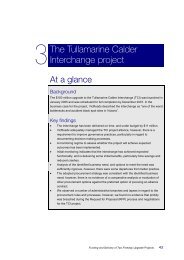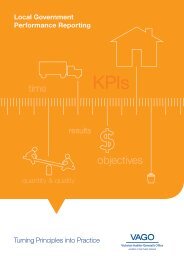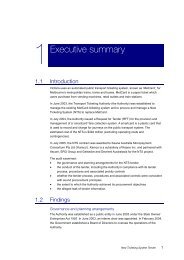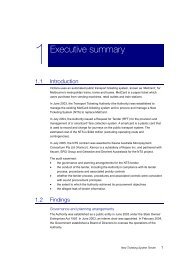Delivering HealthSmart Report - VAGO
Delivering HealthSmart Report - VAGO
Delivering HealthSmart Report - VAGO
Create successful ePaper yourself
Turn your PDF publications into a flip-book with our unique Google optimized e-Paper software.
Realisation of benefits from the HealthSMART program<br />
$<br />
Figure 4A explains the HealthSMART Services operating cost profile and expected<br />
revenue shortfall.<br />
$70,000,000<br />
$60,000,000<br />
$50,000,000<br />
$40,000,000<br />
$30,000,000<br />
$20,000,000<br />
$10,000,000<br />
$-<br />
Figure 4A<br />
HealthSMART Services operating cost profile and<br />
expected revenue shortfall.<br />
$9,282,870<br />
$23,459,734<br />
42 <strong>Delivering</strong> HealthSMART — Victoria's whole-of-health ICT strategy<br />
$41,083,563<br />
$60,989,718<br />
2006/07 2007/08 2008/09 2009/10<br />
Time<br />
Cost Revenue Cumulative subsidy<br />
Source: <strong>VAGO</strong> analysis, based on OHIS projections.<br />
Currently, HealthSMART Services is expected to incur expenses of about $75 million<br />
during the period 2006-10.<br />
Taking into account projected revenue from health agencies of about $8 million per<br />
year, the impact of this funding shortfall is that HealthSMART Services will require an<br />
additional $61 million (i.e., additional funding) to subsidise the arrangement until it<br />
reaches a viable scale.<br />
As for the situation with agency ICT infrastructure, there is no identified long-term<br />
funding source to sustain HealthSMART Services. This risks the ability to maintain a<br />
consistent and industry-standard service to the health sector.<br />
4.4.3 Conclusion<br />
DHS did not have a reliable basis for estimating or defining agency contributions and<br />
whole-of-life costs. This means that DHS was not in a position to accurately estimate<br />
the total cost of ownership of HealthSMART systems and infrastructure, nor what level<br />
of contribution should, or could, be made by health agencies.<br />
The June 2006 program budget revisions resulted in DHS contributing an additional<br />
$35 million. This cost escalation was made in recognition of the inability of agencies to<br />
meet the original DHS expectations of co-contributions.
















